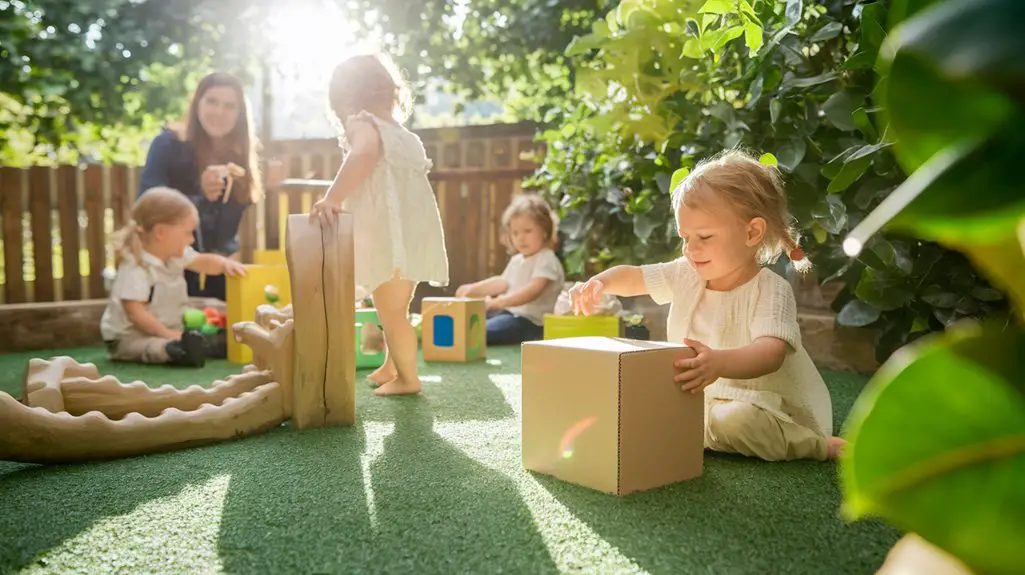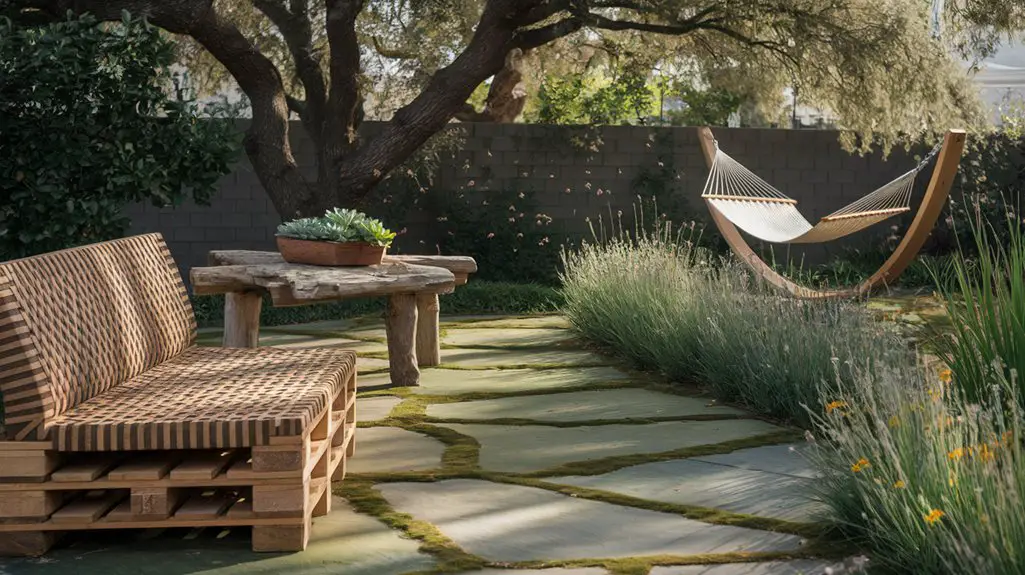Just as a butterfly transforms a garden with minimal impact, your backyard decor choices can beautify your outdoor space while treading lightly on the planet. You’ll discover that sustainable materials don’t require compromising on style or functionality. From reclaimed wooden pallets that tell stories of past lives to biodegradable hemp fabrics that return to the earth, each eco-friendly option represents a small but meaningful step toward a holistic outdoor sanctuary. What sustainable transformation awaits your backyard?
Reclaimed Wooden Pallets for Sustainable Outdoor Furniture
When repurposing wooden pallets for your outdoor space, you’re not just creating beautiful furniture—you’re participating in a circular economy that diverts waste from landfills.
These versatile platforms, often discarded after single transport use, offer tremendous potential for eco-conscious designs.
You’ll find that pallet wood, properly cleaned and sanded, transforms into stunning chairs, tables, and loungers with minimal carbon footprint.
Apply non-toxic, water-based sealants to extend durability while maintaining environmental integrity.
For maximum sustainability, source pallets marked with “HT” (heat-treated) rather than “MB” (methyl bromide)—avoiding harmful chemicals.
Consider integrating modular designs that can be easily disassembled and reconfigured as needs change. Additionally, using recycled materials for your patio decor can further enhance the environmental benefits of your outdoor furniture.
Bamboo: A Fast-Growing Alternative for Garden Structures

While traditional lumber takes decades to mature, bamboo emerges as nature’s engineering marvel, reaching harvest maturity in just 3-5 years. This remarkable grass offers tensile strength comparable to steel while sequestering more carbon during growth than hardwoods.
You’ll find bamboo exceptionally versatile for garden applications—from privacy screens and pergolas to raised beds and trellises. Its natural flexibility allows for creative curved designs that rigid materials can’t achieve.
When sourcing bamboo, look for FSC-certified options harvested from managed plantations to guarantee ecological integrity. Bamboo is also a sustainable material that can enhance the overall eco-friendliness of your outdoor space.
Consider treating your bamboo structures with natural oils rather than chemical preservatives to maintain their low-carbon footprint.
Recycled Glass for Beautiful Pathway Accents

Broken bottles and discarded windowpanes transform into stunning pathway gems that sparkle under sunlight while giving new life to materials otherwise destined for landfills. You’ll reduce your carbon footprint while creating eye-catching garden features that complement natural settings. Incorporating low-impact materials in your projects not only supports sustainable design but also enhances the beauty of your outdoor space.
| Glass Source | Environmental Impact | Visual Effect | Durability | Installation Complexity |
|---|---|---|---|---|
| Wine Bottles | High diversion rate | Deep colors | Excellent | Moderate |
| Window Glass | Reduces silica mining | Transparent glimmer | Very good | Easy |
| Glass Beads | Repurposes waste | Reflective quality | Good | Simple |
| Sea Glass | Beach cleanup | Frosted appearance | Excellent | Easy |
| Light Fixtures | Energy sector reuse | Unique patterns | Moderate | Complex |
When selecting recycled glass, opt for tumbled varieties that won’t harm bare feet. Position them where light hits to maximize their reflective properties and create magical evening pathways.
Natural Stone Elements for Timeless Garden Borders
Unlike manufactured alternatives that drain resources and energy, natural stone offers a climate-positive approach to garden borders that will outlast generations while connecting your outdoor space to Earth’s geological heritage.
The carbon footprint of locally sourced fieldstone, slate, and limestone is minimal compared to concrete products requiring intensive manufacturing processes.
You’ll find these stones require zero maintenance chemicals or treatments that could leach into soil.
Consider dry-stacking techniques that eliminate mortar use altogether, allowing natural drainage patterns while creating microhabitats for beneficial insects and native plant species.
When sourcing stone, opt for reclaimed materials from demolition sites or quarry remnants that would otherwise become waste.
This circular approach honors the material’s inherent durability while minimizing extraction impacts on fragile ecosystems. Additionally, using renewable resources for landscaping not only enhances the aesthetic of your garden but also contributes to a sustainable environment.
Upcycled Metal Materials for Rustic Garden Art
Metal artifacts that have outlived their original purpose present exceptional opportunities for artistic expression in your garden landscape. Old farm implements, bicycle parts, and tools transform into sculptural focal points while diverting materials from landfills.
You’ll find that rusty patinas on repurposed metal items create a natural harmony with surrounding vegetation. Consider converting worn-out watering cans into planters, old bed springs into trellises, or salvaged metal roofing into decorative panels.
When upcycling metal, you’re reducing carbon emissions associated with new product manufacturing while adding character to your outdoor space. Local scrapyards, estate sales, and antique shops often yield unique finds at minimal cost. Additionally, incorporating eco-friendly outdoor art can enhance the overall aesthetic and sustainability of your garden.
Before installation, seal rusty pieces with clear eco-friendly sealant to prevent further deterioration and protect nearby plants from metal runoff.
Cork: The Versatile Sustainable Material for Outdoor Decor
Cork stands as one of nature’s most regenerative materials for eco-conscious outdoor decorating. Harvested from cork oak trees without harming them, this natural resource allows you to create beautiful décor while supporting sustainable forestry practices.
You’ll find cork remarkably versatile for your outdoor spaces. Transform wine corks into planters, coasters, or mosaic wall art that withstands weather fluctuations. Create moisture-resistant path markers by slicing larger cork pieces, or craft floating decorations for water features.
What makes cork truly exceptional is its closed-cell structure—naturally resistant to mold, insects, and water damage. Its production generates minimal emissions compared to plastic alternatives, while its biodegradability guarantees your décor choices won’t burden landfills.
Hemp and Jute: Biodegradable Fabrics for Outdoor Cushions
Hemp and jute fabrics represent the next evolution in sustainable outdoor comfort. These biodegradable textiles offer durability against the elements while minimizing your ecological footprint. You’ll find they’re naturally resistant to mildew and UV damage, making them ideal for outdoor cushions that won’t contribute to landfill waste.
| Material | Benefits | Lifecycle |
|---|---|---|
| Hemp | Water-efficient growth, pesticide-free | Biodegrades in 2-3 years |
| Jute | Carbon-negative production, rapid growth | Composts within 1-2 years |
| Blends | Enhanced texture, customizable durability | Variable decomposition |
When selecting your outdoor textiles, consider these materials’ full lifecycle impact. Their earthy aesthetics complement natural surroundings while their production requires considerably less water and energy than synthetic alternatives. By choosing hemp and jute, you’re investing in both comfort and environmental responsibility.
Conclusion
By embracing these seven eco-friendly materials, you’re not just decorating your backyard—you’re planting the seeds of sustainable living. Like a garden that grows more beautiful with care, your emissions-conscious choices ripple outward, creating harmony between home and planet. Whether you’re crafting with reclaimed wood or arranging recycled glass, each mindful decision weaves together innovation and conservation in your personal outdoor sanctuary.



